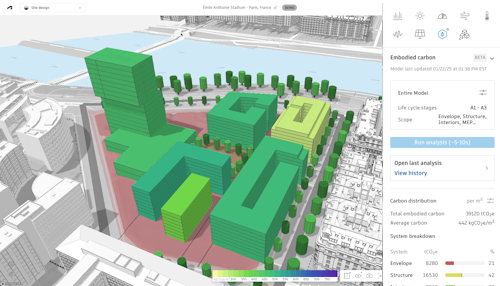Forma’s Embodied Carbon Analysis provides near-instant results, detailing lifecycle embodied carbon data of buildings with accessible visualizations and insights. This helps architects compare embodied carbon across different design scenarios and make informed choices to minimize carbon footprint.

Learning Summary
- What is Forma embodied carbon analysis?
- How to access and use the embodied carbon analysis tool in Forma.
- When should you use Forma’s early-stage carbon insights vs Revit’s detailed carbon analysis.
- Practical examples
- Additional Resources
- FAQ
Go to your Forma Hub to try his workflow.
What is Forma's Embodied Carbon Analysis?
With Forma's embodied carbon analysis, you can see whole-building results in under a minute-right at the start of your design process. As you explore site feasibility and massing studies, Forma helps you understand how your material choices and building form affect carbon impact, so you can make smarter, more sustainable decisions from day one. Unlike Revit's Total Carbon Analysis, which provides detailed assessments later in the design process, Forma gives you fast, early feedback to guide your foundational design choices.
How do I access and use the Embodied Carbon Analysis tool in Forma?
Go to your Forma Hub and create a site to try his workflow.
Step-by-step instructions on using Forma Board within Forma and its integration with Revit:
- Design your building geometries or import an existing model (less that 100MB).
- Define the Building program, envelope cladding type, and primary structural system.
- Run the analysis and take note of the result. This is now your baseline.
- Design multiple alternatives that outperform the baseline, each with varying levels of ambition. In my experience, subdividing a large building into smaller adjacent buildings using different materials and technical approaches can be highly effective. Keep in mind that Forma will consider adjoining buildings as a single entity when calculating facade and MEP requirements.
- Collaborate with the site team to explore various alternatives and establish a clear goal. Ensure that each alternative is accompanied by references to the specific construction solutions assigned. Additionally, provide examples of facades that illustrate how the window-to-wall ratio you've determined appears in practice. Keep in mind that facades with limited daylight access or those exposed to excessive or insufficient sunlight may require distinct solutions.
- Present trade-offs and recommendations to the site owner. Securing shareholder buy-in on sustainable targets is more likely when the team introduces data and solutions early in the site agenda.
How to use Forma and Revit together for Carbon Analysis
Use Forma's Embodied Carbon Analysis early in your design processto quickly evaluate how different building forms and material choices impact the carbon footprint. Its fast, high-level feedback helps you explore multiple concepts during site feasibility and massing studies, guiding you toward low-carbon options before detailed modeling.
Then, as your design progresses, leverage Revit's Total Carbon Analysis (via Insight) for a more detailed and comprehensive assessment that includes both embodied and operational carbon. This lets you refine material quantities, building systems, and energy use with precise data, supporting deeper optimization and certification goals. By combining Forma's rapid, early-stage insights with Revit's detailed, later-stage analysis, you create a continuous workflow that keeps sustainability at the forefront from concept to construction.
Examples
- Quickly evaluate different building massing options to identify low-carbon design strategies before detailed planning begins.
- Compare the embodied carbon impacts of various primary materials to guide sustainable choices in the conceptual design phase.
- Use fast, clear carbon impact visuals to communicate environmental considerations and justify design decisions early in the project.
Additional Resources
Visit our help center to learn more about how to integrate embodied carbon tools into your Forma workflow.
Discover the latest in Autodesk Forma's Embodied Carbon Analysis.
Frequently Asked Questions
How does Forma’s Embodied Carbon Analysis relate to Revit’s Insight Total Carbon Analysis?
Currently, they serve different purposes at different design stages. Forma's analysis uses machine learning and assumptions to provide whole-building embodied carbon results from day one. In contrast, Revit's Insight Total Carbon Analysis offers users full customization of the data behind the analysis, allowing for more precise results- and is used for modeled building elements.
Where does the data behind the Forma Embodied Carbon Analysis come from?
This analysis shows the embodied carbon impact of your buildings in tonnes of carbon dioxide equivalent, or tCO2e. It can run on any number of buildings, regardless of the site limit, in 1-10 seconds and uses the C.Scale data model, developed by EHDD. Review the technical documentation here. While this data spans the globe, it is more comprehensive in North America, Europe, Middle East, and Africa. The carbon intensity values are drawn from region-specific databases such as EC3, Ökobau.dat, and the Carbon Leadership Forum’s baselines.
Go and Try Embodied Carbon in Forma today.